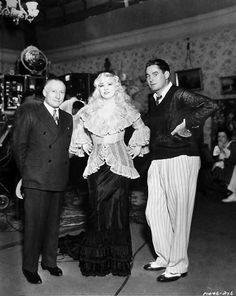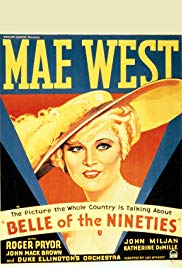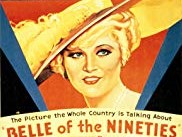Belle of the Nineties **** (1934, Mae West, Roger Pryor, Johnny Mack Brown, John Miljan) – Classic Movie Review 7,491
Paramount Pictures‘ irresistible 1934 musical comedy drama Belle of the Nineties is a highspot for the 41-year-old Mae West in her fourth film.
Director Leo McCarey’s irresistible 1934 musical comedy drama Belle of the Nineties is a highspot for the 41-year-old Mae West in her fourth film, following She Done Him Wrong and I’m No Angel, both co-starring Cary Grant. She is still considered one of the all-time top ten funny ladies of the movies.
With her own screenplay, based on her original story It Ain’t No Sin, here is the great Mae West vamping deliriously away as a saloon singer attraction called Ruby Carter ringing the bell of two beaux, prizefighter Tiger Kid (Roger Pryor) and saloon owner Ace Lamont (John Miljan) of the The Sensation House club in New Orleans. One turns out to be a jewel thief, which helps her make up her mind, when Tiger is set for a title match with champ Ace, who has him steal some of Ruby’s jewels.
If you like lines like ‘a man in the house is worth two in the street’, and who does not?, this Mae Western is for you. OK it is not really a Western as it set in New Orleans, but otherwise it has the hallmarks and the atmosphere.
The film is noted as the first performance of the jazz standard ‘My Old Flame’. West sings the classic ‘My Old Flame’ with the Duke Ellington Orchestra, with the original music by Arthur Johnston and lyrics by Sam Coslow reworked by Duke Ellington, who naturally also pops in as as piano player at the Sensation House. West also sings ‘Memphis Blues’ and ‘St Louis Blues’, written and published in the 1910s by W C Handy, though the film is set in 1890s New Orleans.
Johnston and Coslow also wrote the songs ‘My American Beauty’, ‘When a St Louis Woman Comes Down to New Orleans’ and ‘Troubled Waters’ for the film, which also features ‘At Sundown (When Love Is Calling Me Home)’, a 1927 foxtrot-style song written by Walter Donaldson.
Also in the cast are Johnny Mack Brown [John Mack Brown] as Brooks Claybourne, Katherine DeMille as Molly Brant, John Miljan as Ace Lamont (owner of The Sensation House). Duke Ellington as Piano player (at The Sensation House), James Donlan as Kirby, Stuart Holmes as Dirk, Harry Woods as Slade, Edward Gargan as Stogie, Libby Taylor as Jasmine, Warren Hymer as St. Louis Fighter. Mike Mazurki, Benny Baker as Blackie, Morrie Cohan as Butch, Tyler Brooke as Comedian, Tom Herbert as Gilbert Eddie Borden as Comedian, Fuzzy Knight as Comedian, Gene Austin as St Louis Crooner, and Blue Washington as Doorman.
Jack Wagner provides additional dialogue.
It Ain’t No Sin was to have been the film’s title until the censors objected. According to David Niven, originally more than 40 parrots were trained as a publicity stunt to repeat ‘It Ain’t No Sin’ but the publicity stunt went wrong and the parrots were released into the jungles of South Africa, still squawking ‘It Ain’t No Sin’ endlessly.
Different scenes were shot for different cities and states, and for New York, the final scene was re-shot to include a marriage ceremony with Ruby Carter and the Tiger Kid getting married in front of a justice of the peace, though they were originally to complete their nuptials without a marriage ceremony.
The Tiger Kid role was intended for George Raft, Mae’s co-star in her first film Night after Night (1932), but he turned it down and stage actor Roger Pryor was hired.
Shooting took place from 19 March 1934 until June 1934 and the film was released on 21 September 1934.
It runs only 75 minutes.
It was fairly expensive production at $800,000, and it was less successful than She Done Him Wrong and I’m No Angel, though still profitable for Paramount Pictures.
© Derek Winnert 2018 Classic Movie Review 7,491
Check out more reviews on http://derekwinnert.com

Mae West poses with Paramount head Adolph Zukor (left) and director Leo McCarey on the set of 1934’s Belle of the Nineties.



